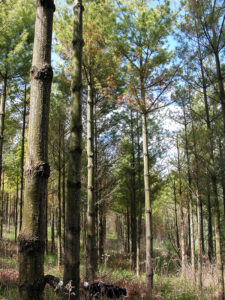By Linda Williams, DNR Forest Health Specialist, Woodruff
Linda.Williams@wisconsin.gov or 920-360-0665

A dead terminal leader, resulting from an attack by white pine weevil. Photo: Linda Williams, Wisconsin DNR.
White pine weevil (Pissodes strobi) is a native insect that can kill the terminal leader of white pine, jack pine and spruce. Wisconsinites often refer to this insect as Tip Weevil.
The insects prefer to attack stout terminal leaders. When the terminal leader dies, lateral branches grow upward and compete to take over apical dominance. This can leave a noticeable crook for decades. If two or more lateral branches take over, forking can occur. New terminal leaders may be attacked in subsequent years, causing more crook or forking.
Spruce and jack pine tend to recover better from weevil damage than white pine because the lateral branch that takes over apical dominance often creates a less prominent crook.

Planting white pine at high densities can help it recover from weeviling. Photo: Linda Williams, Wisconsin DNR.
Early in the spring, prior to bud break, female weevils chew small pits just below the terminal buds and lay one egg per pit. The eggs hatch and larvae begin feeding under the bark, moving downward as they feed and develop. Feeding damage from the larvae cuts off water and nutrients to the expanding terminal buds, causing the new growth to wilt and form a characteristic shepherd’s crook. Weevil larvae will bore downward one to three feet to complete development, which can damage several years of tree growth.
Landowners can consider several management options to minimize impact from white pine weevil including growing white pine in the understory, high-density plantings, applying chemical treatments, manual control or allowing natural biological controls.
Growing white pine in the understory will cause the terminal leader to be smaller in diameter compared to a tree grown in the open. Weevil attack can still happen to some trees grown in the understory, but the percentage of trees attacked each year will be reduced.
As the stand gets older, remove the worst, most weevilled trees and those with forking during regularly scheduled thinnings. This way, the trees that avoided white pine weevil attack, recovered more quickly or grew more vigorously will be your final crop trees.
Planting white pine at high densities also can help minimize damage from white pine weevil. White pine grown in the open typically have stout terminal leaders, and up to 30% of the leaders may be attacked each year. In a high-density planting, the competition helps force lateral branches to take over dominance more quickly, which can help minimize crook.
Pesticide control of weevils is usually not practical or economical in forest settings. Traditional pesticides must be applied early to affect the adult weevils. Systemic insecticides can be used to target the larvae.
Manual control is another management option that involves hand pruning. Damaged terminal leaders are removed and disposed of to kill the larvae and pupae prior to the emergence of adults in July. Manually removing the wilting terminal leader can reduce future crook by making it easier for a lateral branch to take over dominance quickly. Some landowners will go so far as to tie up the best lateral branch to the stub of the dead leader, and in this way they can help minimize crook.
Landowners can also choose to do nothing and let nature take its course. Native parasitic wasps and flies can provide some control. The trees themselves may drown young larvae with pitch before much damage is done. Adult weevils overwintering on the ground may be eaten by mice or voles, and trees will eventually grow tall enough that weevils will no longer attack them.
White pine weevil is only one of the many insects and diseases that can affect white pine.
